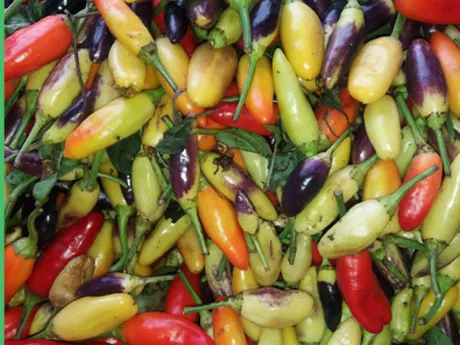The volume of spicy peppers that entered the Central Market of Buenos Aires (MCBA) has experienced a marked rise during the last campaigns. According to the MCBA, this exponential growth is due to the heterogeneity of the seeds used for the production of hot peppers that supply said market, among other causes.
Although this marked increase is relatively new, consumption of this product has increased due to the boom of ethnic foods (Peruvian, Mexican, Bolivian and Oriental) in kitchens around the world.
Chilli or pepper varieties can be spicy or not, a factor that is determined by the presence of an alkaloid called capsaicin, which causes hot peppers to stimulate the thermal receptor of mucous membranes in the palate. The spiciness is measured in the so-called Scoville Scale, in a process that consists of diluting an extract of the pepper in sugar water until the spiciness of that solution can't be detected by a sample of people.
The importance of growing hot peppers goes beyond the kitchen, as the most cultivated species, the Carolina Reaper and Habanero varieties, are the hottest ones and are also used for the industrial extraction of capsaicin, an active ingredient that is used in the United States for the composition of medicines and wood preservatives.
Hot pepper varieties that enter the MCBA
The Jalapeño pepper is of Mexican origin. It has thick walls, a conical shape, a dark green color before ripening (and they turn red when ripe) and they are very spicy. When they have corky streaks they are used in the US for the pickle industry.
There are three varieties of Capsicum annuum: The Aviculare (wild), which is known as chilli or piquin and is very spicy. It is consumed in fresh, pickled, or dry; the Miracielo variety (or Mirasol in Mexico), which has a thick peduncle and erect pose, and the Serrano variety, which is also of Mexican origin and is one of the most popular chillis.
The Locoto pepper receives this name in Bolivia and Argentina while in Peru and Chile it is known as Rocoto. When it is mature and yellow, its called Peron, and when it is red, Manzano. It is the only pepper that has a black seed when its mature.
The Bell pepper (Farolito or Campanita pepper in Argentina) is the most offered variety in the Central Market of Buenos Aires. In addition, it is one of the hottest peppers on the market.
Finally we there is the peruvianum Capsicum, whose vulgar name is escabeche. It is elongated, yellow, and very spicy.



